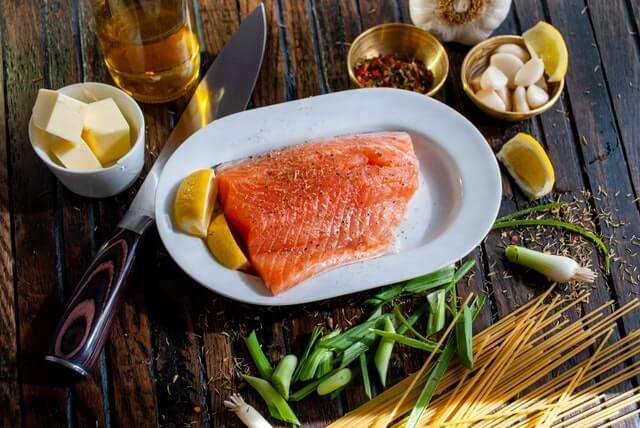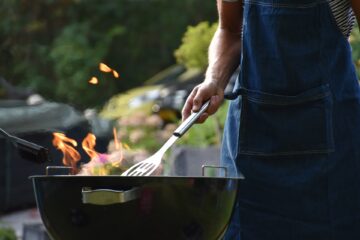Salmon is one of the most nutritious foods I know. It is delicious and loaded with a plethora of nutrients. Besides having numerous health benefits, salmon can be cooked in a couple of different delicious ways. But another way to enjoy this fish is eating it raw! Yes, eating raw salmon is a thing – one that made it gain popularity as a common ingredient in many recipes all over the world.
Salmon is a versatile fish; it is one of the most common ingredients in sashimi, nigiri, rolls, and other sushi dishes. Many people have reservations as to whether or not to eat frozen salmon raw, while some will not even eat frozen salmon in sushi. You, my dear reader, may be in one of those two categories- or both! Not to worry, by the time you are done reading this article, you’d be planning to get raw salmon on your next trip to the grocery store, so that you can make some delicious raw salmon dishes.
Can You Eat Frozen Salmon Raw?
Yes, you can eat frozen salmon raw. Freezing salmon immediately after catching the fish helps to prevent the growth of parasites in the flesh. It also helps to preserve the freshness of the fish. Therefore, frozen salmon is safe to eat raw, so far it is farmed salmon, and has been handled and stored properly.
Can You Eat Atlantic Salmon Raw?
Yes, you can eat Atlantic salmon raw. Atlantic salmon is safe to eat raw, so far it is farm-raised and has been handled and stored properly.
Can You Eat Scottish Salmon Raw?
Yes, Scottish farmed salmon is safe to eat raw as it carries no risk of parasites when eaten raw.

Can You Eat Fresh, Never Frozen Salmon Raw?
It is not advisable to eat fresh, never frozen salmon raw because it may contain parasites that can cause food-borne illnesses. Raw salmon should be flash-frozen to kill parasites and prevent the growth of pathogens.
Can I Eat Frozen Salmon as Sashimi?
Yes, since you can eat frozen salmon raw, you can as well eat it as sashimi. At times, frozen salmon as sashimi can even be better than fresh flash-frozen salmon, if frozen the right way.
What Happens If You Eat Undercooked Frozen Salmon?
Since it is relatively safe to eat frozen salmon raw, it is also the same for undercooked frozen salmon. It is quite safe to eat salmon slightly rare in the middle. However, undercooked salmon can cause food-borne illnesses if contamination had occurred along the preparation process.
Read also: Can I Eat A Sandwich After Tooth Extraction?
How To Prepare Raw Salmon
Eating fish raw always carries some amount of risk hence, it is crucial to prepare your salmon properly. You should know that the process of preparing raw salmon that is safe to eat starts from the point of purchase. Here are some precautions to take when you want to purchase raw salmon:
- Buy your salmon from trusted grocery stores and cold rooms where you are sure that your fish has been handled and stored properly.
- Never buy salmon that has been left out for a long time, instead, buy salmon that is refrigerated, frozen, or kept in ice. At home, keep your fish in the refrigerator or freezer; do not leave it out for more than 2 hours.
- Choose only farmed salmon tobe completely sure that there are no parasites in your salmon. Check the labeling to know whether it is farmed or wild, or you can ask the fishmonger (or store staff) just to be sure.
- Buy whole frozen salmon, that way, it is easier to judge the freshness, as freshness is usually more apparent with the whole salmon.
- Always inspect your salmon at the point of purchase. A visual inspection will help you to detect any odd color, texture, or appearance. Be sure to observe the smell also.
Read also: Can I Eat Pancakes After Tooth Extraction?
Preparation of raw salmon
- To eat frozen salmon raw, it is important to keep the salmon safe to eat raw (that is, after purchase) before you prepare your meal. It is fine to ask them to clean and gut the fish for you at the store, but you can follow the guidelines below to clean and fillet your whole salmon by yourself.
- As soon you get home, put your raw salmon in the freezer to keep it cold while you prepare your utensils and kitchen surfaces. Freezing provides an effective means of inactivating parasites in raw fish.
- Make sure your hands are clean before handling the fish. Also, sanitize your kitchen utensils and food preparation surfaces to avoid cross-contamination which may lead to food poisoning.
- To start preparing your raw salmon, take it out of the freezer and rinse thoroughly under cold running water. Pat your fish dry with a clean kitchen towel and lay it on the chopping board.
- With one hand, hold the fish down on its side, and with the other hand, insert your sharp fillet or salmon knife into the fish vent. Cut the salmon’s belly open by pulling the knife from the vent along the belly toward the head, and stopping just between the gills.
- Make incisions along both sides of the salmon head and cut it off.
- Remove the entrails; be careful not to contaminate the fish flesh.
- Run your knife along the backbone of the fish and slice the salmon into two fillets.
- Remove the bone, fins, and ribcage from salmon fillets.
- To skin the salmon, hold the tail, place your knife above the skin, and slice sideways to pull the skin off at the same time.
- Remove the remaining small rib bones (pin bones) near the tail end of the fillet with needle-nosed pliers and rinse the fillets under running water.
- Freeze the salmon fillets or cut them into portions as required by the dish you want to prepare.
And there you have it! You can eat frozen salmon raw whether as sashimi or in another dish. I bet you’ll need a second helping no matter which raw salmon dish you decide to prepare. Be sure, however, to handle your raw salmon properly from the point of purchase to your table, to prevent food-borne illnesses. All the best preparing your delicious raw salmon.





